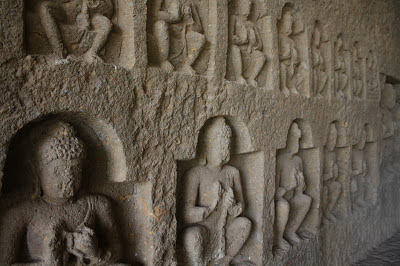He looked like a fisherman too – thin, tanned and half
dressed like he was ready to jump into the water. But, he knew I was coming!
Well, perhaps not me precisely, but a tourist looking for that great photo! That’s
when I realised that what I thought was quite rare and offbeat, was now on the
tourist circuit, thanks to some good marketing by Sri Lanka tourism and another
iconic Steve McCurry photo.
When McCurry shot the
stilt fishermen in 1995 along the Weligama shores, it was a tradition on the
decline – with better boats and fishing methods, fewer felt the need to sit for
hours on poles to earn a living. But, what he achieved was to bring this old
age tradition to the world. Sri Lanka has cashed in on it – hotels carry
paintings of the stilt fisherman, you can even carry home a wooden replica of
them as a memento (We did) – the fishermen of Koggala are now world famous. But,
the awareness couldn’t stop what was fated. Fisherman continued to find more
lucrative ways of earning their living and the authentic fishing method is on
its last legs. But, here’s where the catch is (pun intended) – sometimes, the more
lucrative job allows them to remain fishermen, at least for a flash!
 |
| The fishing stick made of Kitul |
The fisherman who approached me spoke in English. Pointing
to four more of his kind sitting on poles fairly close to the beach he said,
“We are fisherman, this is our job. We have families to support and you must
pay 100 rupees to each fisherman if you want a photo.” Adjusting for what was
obviously not his native tongue; the intonation was still rather rude and
presumptuous. I ignored him and continued towards the beach for a photo. But, a
quick shout from the leader and the four fishermen clambered down the poles. It
was quite the farce really! A few minutes earlier, I had paid 600 LKR to shoot
3 fishermen posing on the poles. But, then they didn’t demand money, rather
requested. As I walked away, the thought that I might have already missed the
bus began to sink in. It appeared that all that remained were mere mannequins;
locals posing as stilt fishermen for a photo. The scoundrels!
 |
| Caught! A fisherman get his catch |
It was later that evening, when we decided to drive back
down towards Weligama (just for a scenic drive along the coast), when I found
them – they were perched modestly on stilts (ritipanna), just the two of them.
My presence didn’t seem to bother them and they continued to pick out tiny
sardines from the blue waters of Koggala. As waves collapsed upon their stilts,
they responded with adroitness in balance. With a whip of their kitul stick,
they plucked them out with ease - their catch now gleaming in the setting sun.
I spent half an hour taking shots, and not a single fisherman approached me for
money, which is why I paid them when leaving. Yes, I paid them; because at the
end of the day, these fishermen will go home and evaluate whether or not they
should fish or perform like circus clowns. I know what I want I would like them
to do, for me and for the next generation of travellers. Thanks to two
strangers, I could share Steve McCurry’s reality.
 |
TIPS
- The fishing stick is made of wood called Kitul. The stilts are also referred to as Ritipanna and the fishing string is called thangoos.
- Search long enough and you might just spot the real fishermen – they fish a little after sunrise and before sunset
- Don’t miss the beautiful beach at Weligama – it is a bay so you get sunrise and sunset there
- Go whale watching at Mirissa, a short drive from Koggala.








































